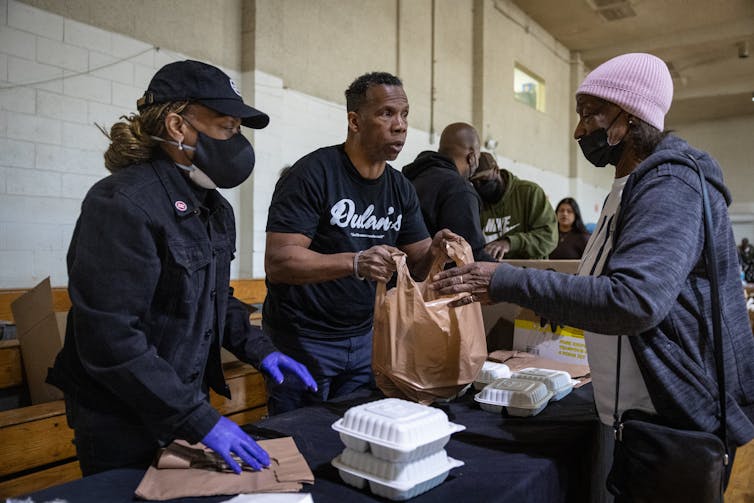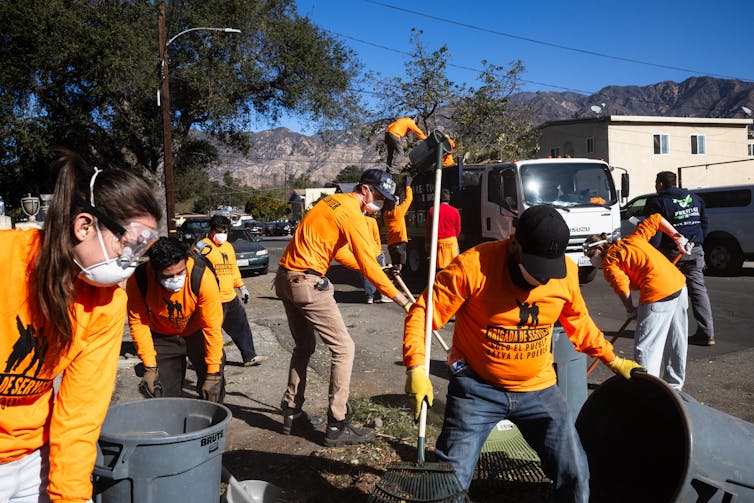Neighbors fill and pass a bucket of pool water to help extinguish a spot fire in Pacific Palisades, Calif., on Jan. 9, 2025.
Tricia Wachtendorf, University of Delaware and James Kendra, University of Delaware
As wildfires swept through neighborhoods on the outskirts of Los Angeles in January 2025, stories about residents there helping their neighbors and total strangers began trickling out on social media.
Accounts of Hollywood stars clearing streets for emergency vehicles to get through and raising money for fire victims were widely circulated. But there were many other examples of less-famous people helping older neighbors to safety, and even showing up with trailers to evacuate horses.
Businesses, including fitness centers, opened their facilities so evacuees could shower or charge their phones. Organizations that routinely work with homeless populations quickly mobilized their members to help ensure people living on the streets and in camps could get to secure, safe locations away from the fires and hazardous air quality.
Disasters, by definition, overwhelm local resources, making civilian responders like these essential. Sixty years of research at the University of Delaware’s Disaster Research Center and by others examining the social aspects of disaster has repeatedly shown effective disaster management requires mobilizing community resources far beyond official channels.
Often the response happens through local groups that form in response to a clear need in the community and with shared skills and interests. And this is exactly what we are witnessing in Los Angeles.
Civilians helping often number in the thousands
The number of those who step up to help during disasters varies by event, but it can be tremendous.
Following the 1995 Oklahoma City bombing, over 6,800 volunteers worked with the Red Cross on the response. That same year, volunteers responding to the Kobe earthquake in Japan logged more than 1 million person-days of activity, a measure of the number of people times the hours they contributed.
People use garden hoses to try to prevent homes from catching fire in Altadena, Calif., on Jan. 8, 2025. Neighbors rushed to help neighbors as the wind blew burning embers into neighborhoods.
In an in-depth study of the Sept. 11, 2001, World Trade Center attacks , we interviewed local residents who used their retired fireboat to pump water for the firefighters at ground zero. Operators of tug, ferry and tour boats in and around New York City immediately responded to quickly evacuate 500,000 people in the area from danger. In fact, the majority of the boats involved belonged to private companies. Other volunteers queued evacuees and organized supplies and rides to get people home.
Over 900 people, most acting in unofficial capacities, were awarded medals or ribbons for their efforts in just the marine response after the World Trade Center attack.
A survey of residents after the 1985 Mexico City earthquake found that nearly 10% of local residents volunteered in the first three weeks of the response. Following the 1989 Loma Prieta earthquake, in California, a survey of residents in Santa Cruz and San Francisco counties found that two-thirds of the public were involved in response activities.
Local businesses are often quick to help in disasters. Greg Dulan, center, who runs a soul food restaurant and food truck, hands out hot meals to wildfire evacuees at a church in Pasadena, Calif., on Jan. 15, 2025.
However, much of the work local residents contribute during and after disasters goes unaccounted for in official reports.
There is no mechanism to quantify the full extent to which a neighbor or a complete stranger helps someone flee from peril. Yet when people are trapped and minutes count, research shows it is family, friends and neighbors who are already on the scene and are most likely to save lives. It’s often everyday citizens who also take on immediate tasks such as debris removal. Providing a phone, a car, a place to do laundry, or a little bit of elbow grease can fill a gap and let firefighters and other formal responders focus on critical operations.
Getting the right help to where it’s needed
Every study of a large-scale disaster conducted by the Disaster Research Center has revealed some level of emergent, informal helping behavior.
The lack of public understanding about the large number of local residents already involved, often including disaster victims themselves, can lead to an influx of outsiders eager to help. Their arrival can actually pose challenges for the disaster response.
When too many people show up, or when people try to operate outside their areas of expertise, they can put themselves and others at further risk. Communities often need supplies, but unsolicited goods of the wrong kind or at the wrong time can create more problems than they solve.
Local groups such as the Pasadena Community Job Center organize volunteers to send them where help is requested. This group is removing debris from streets in Pasadena, Calif., in the wake of the Eaton Fire on Jan. 14, 2025.
So, what can you do to best support these local efforts?
Making a financial contribution to a trusted disaster response or local organization can go a long way to providing the support communities actually need. Organizations such as the American Red Cross or Feeding America, or local community-based groups that routinely work in the area, are often best suited to help where it’s needed the most.
Skilled help will be needed for the long term
Also, remember that disasters don’t end when the emergency is over. Survivors of the Los Angeles-area fires face years of confusing and frustrating recovery tasks ahead.
Offering help after the immediate threat has passed – particularly skilled help, such as experience in construction or expertise in managing insurance and FEMA paperwork – is just as important.
For example, after fires in 1970 destroyed hundreds of homes in the San Diego area, local architects, engineers and contractors donated their time and skills to help people rebuild. Their work was coordinated by a local architect and member of the Chamber of Commerce to ensure projects were assigned to reputable volunteers.
As we recognize the important ways that neighbors and strangers helped those around them, the broader community can support wildfire victims by responding to offering the right help as recovery needs emerge. Just about every skill that is useful in calm times will be needed in these difficult months and years ahead.![]()
Tricia Wachtendorf, Professor of Sociology and Director, Disaster Research Center, University of Delaware and James Kendra, Director, Disaster Research Center and Professor, Public Policy & Administration, University of Delaware
This article is republished from The Conversation under a Creative Commons license. Read the original article.

























































